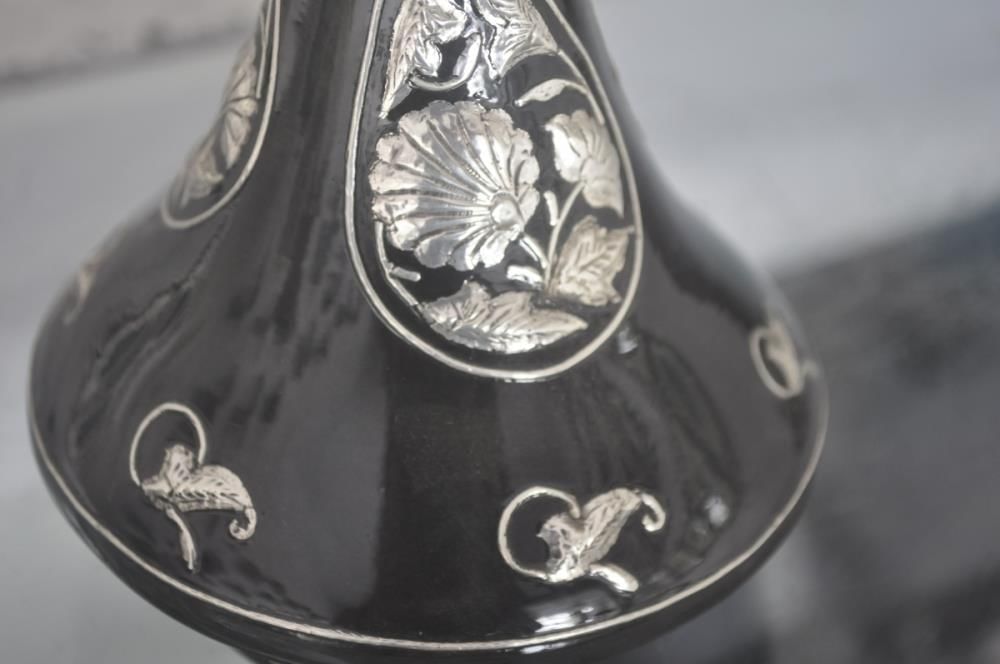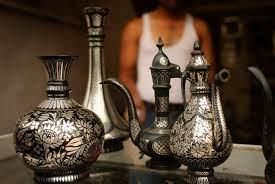UPSC Exam > UPSC Questions > The art of Zar Buland was developed in which...
Start Learning for Free
The art of Zar Buland was developed in which district in Uttar Pradesh?
- a)Meerut
- b)Aligarh
- c)Lucknow
- d)Mirzapur
Correct answer is option 'C'. Can you explain this answer?
Most Upvoted Answer
The art of Zar Buland was developed in which district in Uttar Prades...
The correct answer is Lucknow.

Key-Points
- Zar Buland's work was developed in Lucknow district in Uttar Pradesh.
- Zar Buland is a variation in the Bidri work of Karnataka.
- It looks similar to the Tanjore metal works plates with minute differences
- In this, the designs are raised above the surface.
- The inlaying of silver is done after the pattern is carved on the silver sheet.

Additional Information
- Bidriware is an art form that has its origin from Bidar in Karnataka.
- This art form was introduced in India by Bahmani Sultans.
It has 4 variations:
- Teh nashin
- Aftabi
- Tarkashi
- Zar Buland or Zar Mashin
- Bidri Metal Work Centers:
- Hyderabad
- Bidar

Free Test
FREE
| Start Free Test |
Community Answer
The art of Zar Buland was developed in which district in Uttar Prades...
Introduction:
The art of Zar Buland is a unique form of embroidery that originated in Lucknow, a district in Uttar Pradesh, India. This art form has a rich history and is known for its intricate designs and craftsmanship.
History of Zar Buland:
Zar Buland embroidery has a long history that dates back to the era of the Mughals in India. It was during the reign of the Mughal emperor Akbar that this art form flourished in Lucknow. The art was patronized by the royal court and the nobility of the region, leading to its development and refinement over time.
Characteristics of Zar Buland:
Zar Buland embroidery is characterized by its exquisite detailing and use of gold and silver threads. The embroidery is primarily done on fabrics such as silk, satin, and velvet, which provide a rich and luxurious base for the intricate designs. The motifs used in Zar Buland embroidery often include floral patterns, paisleys, and geometric shapes.
Techniques and Process:
The process of creating Zar Buland embroidery involves meticulous handwork and skill. The artisans use a fine needle and threads made of gold or silver to create the intricate designs. The threads are carefully stitched onto the fabric, following the predetermined pattern. The embroidery is done using various techniques such as satin stitch, stem stitch, and chain stitch to create different textures and effects.
Significance and Influence:
Zar Buland embroidery is considered a highly skilled and prestigious art form in Uttar Pradesh. It is often used in the creation of bridal and formal wear, as well as in the embellishment of home furnishings and accessories. The art form has also gained recognition and popularity internationally, with its intricate designs being showcased in fashion shows and exhibitions.
Lucknow as the Hub of Zar Buland:
Lucknow, the capital city of Uttar Pradesh, has been the center for the development and promotion of Zar Buland embroidery. The city has a rich cultural heritage and has been known for its patronage of the arts. The royal courts of Lucknow played a significant role in nurturing and promoting this art form, which eventually spread to other parts of the region.
Conclusion:
Zar Buland embroidery is a significant art form that originated in Lucknow, Uttar Pradesh. Its intricate designs, skilled craftsmanship, and historical significance make it a valuable cultural asset. The art form continues to thrive in Lucknow and has become synonymous with the city's rich cultural heritage.
The art of Zar Buland is a unique form of embroidery that originated in Lucknow, a district in Uttar Pradesh, India. This art form has a rich history and is known for its intricate designs and craftsmanship.
History of Zar Buland:
Zar Buland embroidery has a long history that dates back to the era of the Mughals in India. It was during the reign of the Mughal emperor Akbar that this art form flourished in Lucknow. The art was patronized by the royal court and the nobility of the region, leading to its development and refinement over time.
Characteristics of Zar Buland:
Zar Buland embroidery is characterized by its exquisite detailing and use of gold and silver threads. The embroidery is primarily done on fabrics such as silk, satin, and velvet, which provide a rich and luxurious base for the intricate designs. The motifs used in Zar Buland embroidery often include floral patterns, paisleys, and geometric shapes.
Techniques and Process:
The process of creating Zar Buland embroidery involves meticulous handwork and skill. The artisans use a fine needle and threads made of gold or silver to create the intricate designs. The threads are carefully stitched onto the fabric, following the predetermined pattern. The embroidery is done using various techniques such as satin stitch, stem stitch, and chain stitch to create different textures and effects.
Significance and Influence:
Zar Buland embroidery is considered a highly skilled and prestigious art form in Uttar Pradesh. It is often used in the creation of bridal and formal wear, as well as in the embellishment of home furnishings and accessories. The art form has also gained recognition and popularity internationally, with its intricate designs being showcased in fashion shows and exhibitions.
Lucknow as the Hub of Zar Buland:
Lucknow, the capital city of Uttar Pradesh, has been the center for the development and promotion of Zar Buland embroidery. The city has a rich cultural heritage and has been known for its patronage of the arts. The royal courts of Lucknow played a significant role in nurturing and promoting this art form, which eventually spread to other parts of the region.
Conclusion:
Zar Buland embroidery is a significant art form that originated in Lucknow, Uttar Pradesh. Its intricate designs, skilled craftsmanship, and historical significance make it a valuable cultural asset. The art form continues to thrive in Lucknow and has become synonymous with the city's rich cultural heritage.

|
Explore Courses for UPSC exam
|

|
Question Description
The art of Zar Buland was developed in which district in Uttar Pradesh?a)Meerutb)Aligarhc)Lucknowd)MirzapurCorrect answer is option 'C'. Can you explain this answer? for UPSC 2025 is part of UPSC preparation. The Question and answers have been prepared according to the UPSC exam syllabus. Information about The art of Zar Buland was developed in which district in Uttar Pradesh?a)Meerutb)Aligarhc)Lucknowd)MirzapurCorrect answer is option 'C'. Can you explain this answer? covers all topics & solutions for UPSC 2025 Exam. Find important definitions, questions, meanings, examples, exercises and tests below for The art of Zar Buland was developed in which district in Uttar Pradesh?a)Meerutb)Aligarhc)Lucknowd)MirzapurCorrect answer is option 'C'. Can you explain this answer?.
The art of Zar Buland was developed in which district in Uttar Pradesh?a)Meerutb)Aligarhc)Lucknowd)MirzapurCorrect answer is option 'C'. Can you explain this answer? for UPSC 2025 is part of UPSC preparation. The Question and answers have been prepared according to the UPSC exam syllabus. Information about The art of Zar Buland was developed in which district in Uttar Pradesh?a)Meerutb)Aligarhc)Lucknowd)MirzapurCorrect answer is option 'C'. Can you explain this answer? covers all topics & solutions for UPSC 2025 Exam. Find important definitions, questions, meanings, examples, exercises and tests below for The art of Zar Buland was developed in which district in Uttar Pradesh?a)Meerutb)Aligarhc)Lucknowd)MirzapurCorrect answer is option 'C'. Can you explain this answer?.
Solutions for The art of Zar Buland was developed in which district in Uttar Pradesh?a)Meerutb)Aligarhc)Lucknowd)MirzapurCorrect answer is option 'C'. Can you explain this answer? in English & in Hindi are available as part of our courses for UPSC.
Download more important topics, notes, lectures and mock test series for UPSC Exam by signing up for free.
Here you can find the meaning of The art of Zar Buland was developed in which district in Uttar Pradesh?a)Meerutb)Aligarhc)Lucknowd)MirzapurCorrect answer is option 'C'. Can you explain this answer? defined & explained in the simplest way possible. Besides giving the explanation of
The art of Zar Buland was developed in which district in Uttar Pradesh?a)Meerutb)Aligarhc)Lucknowd)MirzapurCorrect answer is option 'C'. Can you explain this answer?, a detailed solution for The art of Zar Buland was developed in which district in Uttar Pradesh?a)Meerutb)Aligarhc)Lucknowd)MirzapurCorrect answer is option 'C'. Can you explain this answer? has been provided alongside types of The art of Zar Buland was developed in which district in Uttar Pradesh?a)Meerutb)Aligarhc)Lucknowd)MirzapurCorrect answer is option 'C'. Can you explain this answer? theory, EduRev gives you an
ample number of questions to practice The art of Zar Buland was developed in which district in Uttar Pradesh?a)Meerutb)Aligarhc)Lucknowd)MirzapurCorrect answer is option 'C'. Can you explain this answer? tests, examples and also practice UPSC tests.

|
Explore Courses for UPSC exam
|

|
Signup for Free!
Signup to see your scores go up within 7 days! Learn & Practice with 1000+ FREE Notes, Videos & Tests.























